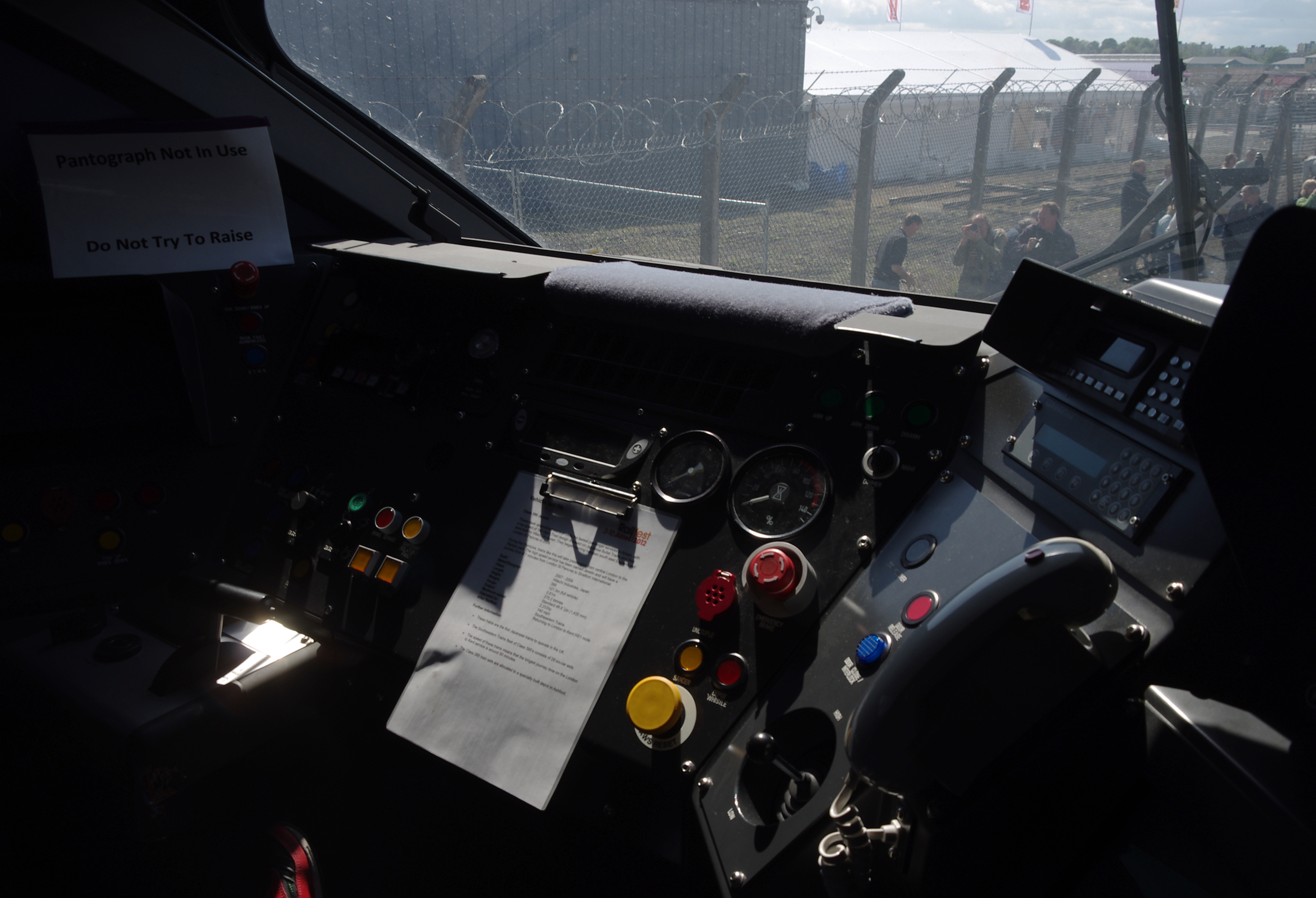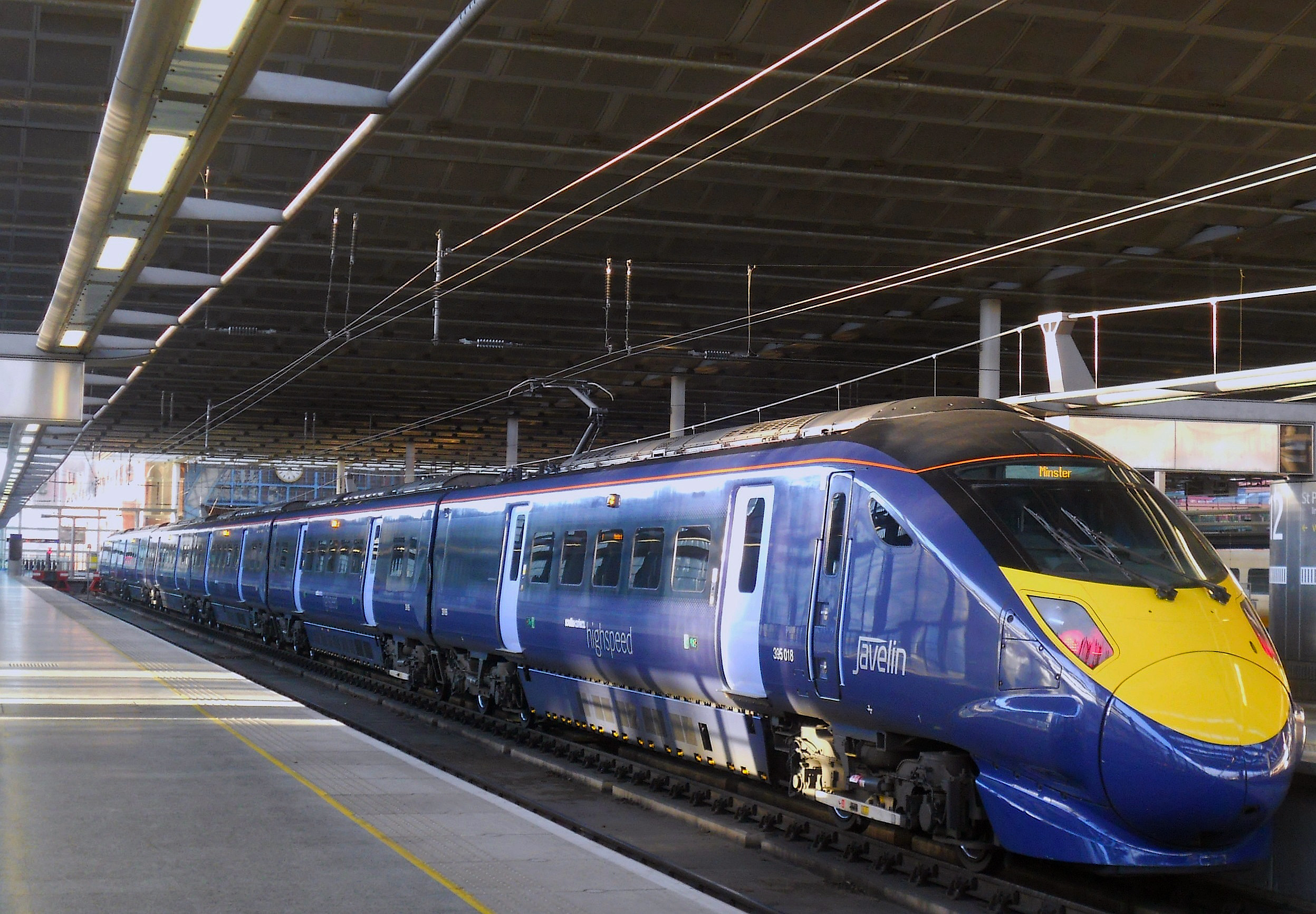|
British Rail Class 375
The British Rail Class 375 is an electric multiple unit train that was built by Bombardier Transportation (previously Adtranz) at Derby Litchurch Lane Works, from 1999 to 2005. The class form part of the Electrostar family of units, which also includes classes 357, 376, 377, 378, 379 and 387, is the most numerous type of EMU introduced since the privatisation of British Rail. These units form the basis of Southeastern's mainline fleet. Description Introduced into service in 2000, these trains are owned by Eversholt Rail Group (formerly HSBC Rail) and leased to Southeastern for operation from London to Kent and parts of East Sussex. The Class 375 is the principal train used by Southeastern, and replaced the slam-door Mark 1 derived stock, which was more than 40 years old and did not meet modern health and safety requirements and replaced the 16 Class 365s which were transferred to WAGN in 2004. All units have been converted from Tightlock to Dellner couplers. Refurb ... [...More Info...] [...Related Items...] OR: [Wikipedia] [Google] [Baidu] |
Ramsgate EMU Depot
Ramsgate EMUD is a traction maintenance depot located in Ramsgate, Kent, England. The depot is situated on the Chatham Main Line and is immediately northwest of Ramsgate railway station, Ramsgate station, with access to the maintenance facilities and stabling sidings almost exclusively accessible from the Margate direction. Trains coming from Minster junction can only access the depot reception roads, the carriage cleaning shed (roads 1-4) and stabling roads 5-6 without reversing. The depot code is RE. Accidents and incidents * On 28 January 1993, British Rail Class 411, 4CEP unit 1521 overran the buffers at the depot, with one driving carriage left perched precariously above houses. Three similar incidents had happened in the previous ten years. Allocation The depot is operated by Southeastern (train operating company), Southeastern and maintains British Rail Class 375, Class 375, British Rail Class 377, 377, British Rail Class 395, 395, British Rail Class 465, 465 and Briti ... [...More Info...] [...Related Items...] OR: [Wikipedia] [Google] [Baidu] |
British Rail Class 387
The British Rail Class 387 is a type of electric multiple unit passenger train built by Bombardier Transportation as part of the Electrostar family. A total of 107 units were built, with the first train entering service with Thameslink in December 2014. The trains are currently in service with Great Western Railway, Govia Thameslink Railway, and Heathrow Express. The Class 387 is a variation of the '' Bombardier Electrostar'', albeit with dual-voltage capability (which allows units to run on 750VDC third rail as well as use 25kVAC OLE). The class were the final rolling stock orders based on the Bombardier Electrostar family with 2,805 vehicles built over 18 years between 1999 and 2017. Description Class 387/1 The first Class 387/1s were ordered for the Thameslink route, which enabled the existing units to be transferred to Northern Rail for use on the newly electrified Manchester Victoria to Liverpool via Newton-le-Willows route. On behalf of the Department for Transport, ... [...More Info...] [...Related Items...] OR: [Wikipedia] [Google] [Baidu] |
Southeastern (train Operating Company 2006–2021)
London & South Eastern Railway Limited, trading as Southeastern, was a British train operating company owned by Govia that operated passenger rail services in South East England. It was the key operator of commuter and regional services in South East London and Kent, and also served parts of East Sussex. Southeastern trains operated on three main routes: the South Eastern Main Line from London Cannon Street and London Charing Cross to Dover via Sevenoaks; the Chatham Main Line between London Victoria and Dover/Ramsgate via the Medway towns; and High Speed 1 from London St Pancras. Southeastern began operations on 1 April 2006 as the franchisee for the new Integrated Kent franchise (IKF), replacing the publicly owned South Eastern Trains on the former South Eastern franchise. Southeastern received a number of extensions, with the franchise scheduled to end on 1 April 2020, until a new contract was agreed on 30 March 2020, running for up to two years. The Southeastern franch ... [...More Info...] [...Related Items...] OR: [Wikipedia] [Google] [Baidu] |
Wheel Slide Protection
Wheel slide protection and wheel slip protection are railway terms used to describe automatic systems used to detect and prevent wheel-slide during braking or wheel-slip during acceleration. This is analogous to ABS and traction control systems used on motor vehicles. It is particularly important in slippery rail conditions. Sanding Sanding is one method of reducing wheel slip or slide. Locomotives and Multiple units have sandboxes which can deliver dry sand to the rails in front of the wheels. This may be initiated automatically when the Wheel Slide Protection system senses loss of adhesion, or the driver can operate it manually. Sanding may be connected to a computer system that determines the train's direction and where the sand should be applied: either forward or aft of the trucks. In older locomotives there was a manual lever attached to a valve that had three positions: Off, Forward, and Aft. Automatic control systems Wheel Slide Protection (WSP) equipment is generall ... [...More Info...] [...Related Items...] OR: [Wikipedia] [Google] [Baidu] |
Slippery Rail
Slippery rail, or low railhead adhesion, is a condition of railways (railroads) where contamination of the railhead reduces the traction between the wheel and the rail. This can lead to wheelslip when the train is taking power, and wheelslide when the train is braking. One common cause of contamination is fallen leaves that adhere to the railhead (top surface) of railway tracks. The condition results in significant reduction in friction between train wheels and rails, and in extreme cases can render the track temporarily unusable. In Britain, the situation is colloquially referred to as "leaves on the line". Low adhesion caused by weather Railhead contamination caused by weather conditions can occur at any time of year. The leaf fall season causes the most disruption to rail operations. In heavily deciduous forested areas like the American Mid-Atlantic states, New England, many parts of Europe including the UK, and Southern Ontario, Canada, the problem can arise. Where the ... [...More Info...] [...Related Items...] OR: [Wikipedia] [Google] [Baidu] |
East Sussex
East Sussex is a ceremonial and non-metropolitan county in South East England on the English Channel coast. It is bordered by Kent to the north and east, West Sussex to the west, and Surrey to the north-west. The largest settlement in East Sussex is the city of Brighton and Hove. History East Sussex is part of the historic county of Sussex, which has its roots in the ancient kingdom of the South Saxons, who established themselves there in the 5th century AD, after the departure of the Romans. Archaeological remains are plentiful, especially in the upland areas. The area's position on the coast has also meant that there were many invaders, including the Romans and later the Normans. Earlier industries have included fishing, iron-making, and the wool trade, all of which have declined, or been lost completely. Governance Sussex was historically sub-divided into six rapes. From the 12th century the three eastern rapes together and the three western rapes together had ... [...More Info...] [...Related Items...] OR: [Wikipedia] [Google] [Baidu] |
British Rail Class 395
The British Rail Class 395 ''Javelin'' is a dual-voltage electric multiple-unit (EMU) passenger train built by Hitachi Rail as part of the Hitachi A-train ''AT300'' family for high-speed commuter services on High Speed 1 and elsewhere on the South Eastern franchise. The whole fleet is operated by Southeastern. The Class 395 can operate at a maximum speed of under 25kVAC overhead electrification on High Speed 1, and on 750VDC third rail supply on conventional lines. It is typically formed as a six-car train, although they can be rapidly coupled to one another to form a 12-car train as required. The type, which was entirely manufactured in Japan, is the first Hitachi-built rail vehicle to be sold to a European customer, as well as being the first British order for a Japanese train. The fleet was ordered during June 2005 by HSBC Rail, and was delivered to the UK between August 2007 and August 2009. Following the completion of fault-free running six months ahead of schedule, a ... [...More Info...] [...Related Items...] OR: [Wikipedia] [Google] [Baidu] |
Dellner Coupling
Dellner Couplers AB is a Swedish original equipment manufacturer of train connection systems as couplers, gangway systems and dampers. The headquarter of the company is located in Vika in the Falun Municipality. Dellner is owned by the investment organisation EQT Partners and has 22 subsidiaries worldwide with more than 1,200 employees. History Dellner was founded in 1941 by the Swedish engineer Jan Dellner. The first customer was Swedish State Railways, for whom the Engineering Bureau Dellner produced automatic couplers. In the following years, the company, based in the small town of Vika in central Sweden, expanded its business and supplied automatic couplers to numerous customers in Europe, such as the Warsaw Metro, Paris Metro, SNCF, Rome Metro and Italian State Railways. From 1982 onwards, train couplers were also supplied to countries outside Europe. At that time Dellner had a total of 80 employees in Sweden, the US and Canada. From 1984 Dellner was the first manufacturer ... [...More Info...] [...Related Items...] OR: [Wikipedia] [Google] [Baidu] |
British Rail Mark 1
British Railways Mark 1 is the family designation for the first standardised designs of railway carriages built by British Railways (BR) from 1951 until 1974, now used only for charter services on the main lines or on preserved railways. Following nationalisation in 1948, BR had continued to build carriages to the designs of the "Big Four" companies (the Great Western, Southern, London, Midland and Scottish and London and North Eastern railways), and the Mark 1 was intended to be the standard carriage design for use across all lines, incorporating the best features of each of the former companies' designs. It was also designed to be much stronger than previous designs, to provide better protection for passengers in the event of a collision or derailment. The Mark 1 coaches were built in two distinct tranches: the early vehicles (1951–1960) and the 'Commonwealth' stock (named from the type of bogie used) from 1961 onwards. Construction The design was used for hauled passen ... [...More Info...] [...Related Items...] OR: [Wikipedia] [Google] [Baidu] |
Eversholt Rail Group
Eversholt Rail Group is a British rolling stock company (ROSCO). Together with Angel Trains and Porterbrook, it is one of the three original ROSCOs created as a result of the privatisation of British Rail. Eversholt was established in March 1994 and was promptly privatised one year later via a £580 million management buyout. During February 1997, it was acquired by the Midland Bank and briefly renamed ''Forward Trust'', and again renamed ''HSBC Rail''. The company has primarily operated within the UK market, but between 2000 and 2009, HSBC Rail was also active on the European leasing market as well, before selling off this arm of the business to rival leasing firm Beacon Rail. As HSBC Rail, it was involved in the supply of 28 British Rail Class 395 high speed train sets from Hitachi Europe in a £250million contract. The company also submitted an unsolicited response to the Intercity Express Programme, which was dismissed. In January 2010, HSBC Rail was rebranded back to the Ev ... [...More Info...] [...Related Items...] OR: [Wikipedia] [Google] [Baidu] |





